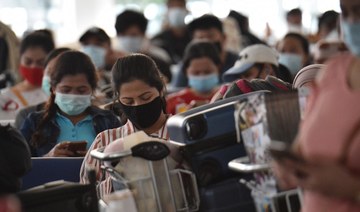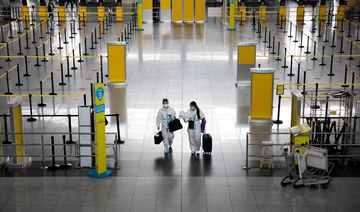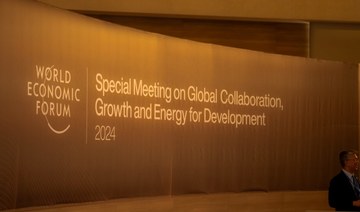MANILA: Philippine health officials warned Friday of a possible surge in coronavirus infections as the first locally transmitted cases of the highly contagious Delta variant were recorded and more than three million people went into lockdown.
Eleven local cases of the more virulent strain have been detected, including two in the national capital region, the health department said, citing results of genome sequencing conducted this week.
The cases dated back to May and June and authorities were checking to ensure they had been “appropriately traced and managed,” Health Undersecretary Rosario Vergeire told reporters.
“The government has started preparing our health system,” Vergeire said.
More hospital beds were being made available for COVID-19 patients and oxygen supplies increased in case of a “surge” in cases, she said.
The Philippines has recorded around 1.5 million coronavirus infections since the start of the pandemic, the second-highest in Southeast Asia.
But a deficient contact tracing system means the real figure is likely much higher.
Record infections earlier this year sent the national capital region and surrounding provinces into lockdown as soaring numbers of patients threatened to overwhelm hospitals.
Cases have eased in recent months, hovering around 5,000 or 6,000 a day. COVID-19 rules have been relaxed in many parts of the country but masks and face shields are mandatory in public.
But as the Delta variant fuels infections around the world, the Philippines has tightened border restrictions for travelers from some of the worst-hit countries, including neighboring Indonesia.
Until this week cases of the strain had been detected only among quarantined Filipino workers returning from overseas.
Among the 11 local infections, six were on the southern island of Mindanao and were “part of a large cluster of cases.” All of them have recovered.
One of the two cases in the national capital region died, the department said.
Asked about the delay in detecting the Delta variant, Philippine Genome Center executive director Cynthia Saloma said they had limited processing capacity and had prioritized samples from hotspot areas.
Some regions were also slow to submit samples, she said.
More than three million people living in areas where the Delta infections were found have been sent into lockdown until the end of the month.
Residents in the central province of Iloilo and the southern cities of Cagayan de Oro and Gingoog have been ordered to stay home, non-essential business shuttered and religious services banned.
The detection of Delta infections in the community comes as the Philippines struggles to vaccinate its population of 110 million due to tight global supplies and logistical challenges.
Some cities recently suspended inoculations after running out of shots — just as vaccine hesitancy among Filipinos declines.
Only 4.3 million people are fully vaccinated while more than 10 million have received their first jab.
Philippines warns coronavirus ‘surge’ possible after Delta strain detected
https://arab.news/63jg2
Philippines warns coronavirus ‘surge’ possible after Delta strain detected
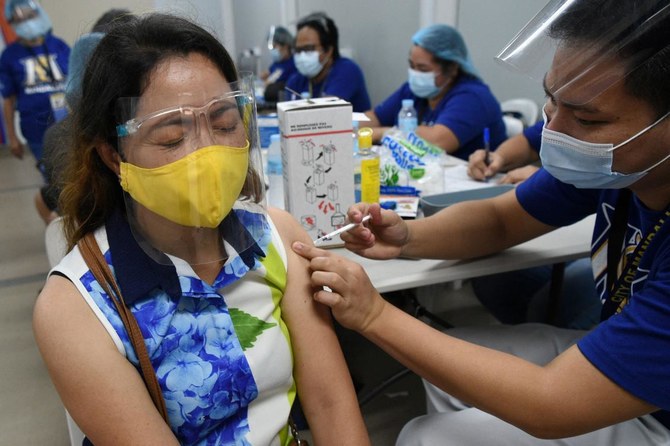
- Eleven local cases of the more virulent strain have been detected
- Philippines tightened border restrictions for travelers from some of the worst-hit nations
North Korea fires ballistic missile, South Korea’s military says

South Korea’s Joint Chiefs of Staff did not immediately provide details of the projectile or its trajectory.
North Korea has launched a range of ballistic and cruise missiles as well as tactical rockets in recent months, describing them as part of a program to upgrade its defensive capabilities.
Earlier on Friday, the powerful sister of North Korea leader Kim Jong Un said its tactical rockets were intended solely as a deterrent against South Korean military aggression, while denying that Pyongyang was exporting the weapons.
The missile launch comes at the same time as a visit by Russian President Vladimir Putin to the Chinese northeastern city of Harbin.
French police ‘neutralized’ armed person who tried to set fire to synagogue in Rouen — Darmanin

- The incident occurred early on Friday morning
PARIS: French police officers in Rouen ‘neutralized’ an armed individual who was intent on setting fire to the town’s synagogue, Interior Minister Gerald Darmanin said on Friday.
The incident occurred early on Friday morning, Darmanin said in a post on social network X.
Regional French broadcaster France 3 said fire fighters were on the site.
Rouen mayor said in a post the Normandy town was ‘battered and shocked’.
Against the backdrop of tensions in Middle East and Israel’s ground offensive in the Gaza strip, France recently raised its alert level to the highest level.
Suspected gunshots near Israeli embassy in Stockholm prompt police cordon
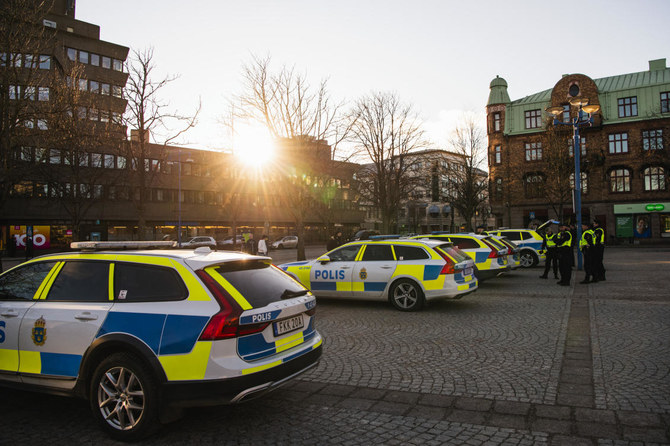
STOCKHOLM: Swedish police have detained several people and cordoned off an area in Stockholm after a patrol heard suspected gunshots, they said on Friday, with the Israeli embassy located in the closed-off area.
"A police patrol at Strandvagen in Stockholm heard bangs and suspected there had been a shooting," police said on their website, adding that the affected area lay between the capital's Djurgarden Bridge, its Nobel Park and the Oscar Church.
Several people have been detained and an investigation has been launched into a suspected serious weapons crime, they added.
"In connection with the ongoing forensic investigation, findings have been made that strengthen the suspicions that a shooting took place," police said on its website.
Reuters could not immediately reach police and the Israeli embassy for comment.
Swedish news agency TT said police declined to comment on whether there was a link between the incident and the Israeli embassy.
‘Hindu nation’: Religion trumps caste in India vote

- Modi’s strategy of appealing to pan-Hindu unity has reaped political dividends
- Modi government accused of marginalizing country’s 200-million-plus Muslims
AGRA, India: Born at the bottom of the Hindu faith’s rigid caste system, voters like Anil Sonkar will determine whether Indian Prime Minister Narendra Modi returns to power next month.
More than two-thirds of India’s 1.4 billion people are estimated to be on the lower rungs of a millennia-old social hierarchy that divides Hindus by function and social standing.
Politicians of all stripes have courted lower caste Indians with affirmative action programs, job guarantees and special subsidies to mitigate long-standing discrimination and disadvantage.
But Modi’s Hindu-nationalist Bharatiya Janata Party (BJP) has established itself as India’s dominant political force with a different pitch: think of your religion first, and caste second.
“There are no economic opportunities and business has never been so bad for me,” said Sonkar, a 55-year-old fishmonger and a member of the Dalit castes, once disparagingly known as “untouchables.”
“But under this government, we feel safe and proud as Hindus,” he told AFP in the tourist city of Agra, home of the Taj Mahal. “That is why, despite everything, I voted for Modi.”
Modi’s party is expected to easily win this year’s national election once it concludes in June, in large part due to his government’s positioning of the Hindu faith at the center of its politics.
His government has been accused in turn of marginalizing the country’s 200-million-plus Muslims, leaving many among them fearful for their futures in India.
But its strategy of appealing to pan-Hindu unity, and directing the faith’s internal frictions outwards, has reaped political dividends.
“The BJP’s base among the marginalized has grown over every election since 2014,” political scientist and author Sudha Pai told AFP.
The party, she added, had successfully forged a new pan-Hindu political coalition by showing respect to the “cultural symbols, icons and history” of low-caste voters, and in the process furthering its goal of building a “Hindu nation.”
Caste remains a crucial determinant of one’s station in life at birth, with higher castes the beneficiaries of ingrained cultural privileges, lower castes suffering entrenched discrimination, and a rigid divide between both.
Modi himself belongs to a low caste, but the elite worlds of politics, business and culture are largely dominated by high-caste Indians.
Less than six percent of Indians married outside their caste, according to the country’s most recent census in 2011.
Modi’s political coalition has managed to bridge this internal divide by trumpeting a vision of a resurgent and assertive Hindu faith.
The prime minister began the year by inaugurating a grand temple to the Hindu deity Ram, built on the site of a centuries-old mosque razed by Hindu zealots decades earlier.
Construction of the temple fulfilled a long-standing demand of Hindu activists and was widely celebrated by Hindu voters, whatever their caste group.
Modi’s rise also coincided with the declining fortunes of caste-based political parties that had dominated politics for decades in Uttar Pradesh, India’s most populous state with more people than Nigeria and its most important electoral battleground.
Many in the state accused these parties of directing welfare programs and other benefits of political power to their own caste groups, a situation they say changed when Modi came to power and made them available for all disadvantaged voters.
“The soles of my slippers wore off as I ran around trying to get a card for free rations,” homemaker Munni Devi, 62, told AFP at a BJP campaign rally over the din of frenzied drum beats and music.
“But Modi gave me one immediately after coming to power,” she told AFP.
The BJP has been able to unite a broad array of caste groups into a single bloc of support, but caste discrimination remains a fact of life both in politics and society at large.
Despite Modi’s own low-caste origins, the senior ranks of his ministry, party and civil service remain overwhelmingly dominated by upper-caste functionaries.
“Our lawmaker is from our caste and from the BJP,” said farmer Patiram Kushwaha, a Modi supporter reconsidering his allegiance.
“He cannot do anything for us because those sitting at the top don’t listen to him.”
More than two dozen opposition parties in this year’s poll have campaigned on a joint pledge to address the structural causes of discrimination by staging a caste-based national census and redirecting resources to the most disadvantaged.
Analysts nonetheless expect Modi to triumph convincingly over the opposition bloc, but Neelanjan Sircar, of the Center for Policy Research think-tank in New Delhi, said the BJP faced a monumental challenge in holding its coalition together over the long term.
“This balancing act of keeping together groups which don’t really get along with each other is extremely tough in the long run,” he told AFP. “At some point, you have to face the demons of those contradictions.”
UN reports improved prospects for the world economy and forecasts 2.7 percent growth in 2024

- The mid-2024 report says the world economy is now projected to grow by 2.7 percent this year and by 2.8 percent in 2025
UNITED NATIONS: The United Nations reported improved prospects for the world economy since its January forecast on Thursday, pointing to a better outlook in the United States and several large emerging economies including Brazil, India and Russia.
According to its mid-2024 report, the world economy is now projected to grow by 2.7 percent this year – up from the 2.4 percent forecast in its January report – and by 2.8 percent in 2025. A 2.7 percent growth rate would equal growth in 2023, but still be lower than the 3 percent growth rate before the COVID-19 pandemic began in 2020.
“Our prognosis is one of guarded optimism, but with important caveats,” Shantanu Mukherjee, director of the UN’s Economic Analysis and Policy Division, told a news conference launching the report.
The report pointed to interest rates that are higher for longer periods, debt repayment challenges, continuing geopolitical tensions and climate risks especially for the world’s poorest countries and small island nations.
Mukherjee said inflation, which is down from its 2023 peak, is both “a symptom of the underlying fragility” of the global economy where it still lurks, “but also a cause for concern in its own right.”
“We’ve seen that in some countries inflation continues to be high,” he said. “Globally, energy and food prices are inching upward in recent months, but I think a bit more insidious even is the persistence of inflation above the 2 percent central bank target in many developed countries.”

The UN forecast for 2024 is lower than those of both the International Monetary Fund and the Organization for Economic Cooperation and Development.
In mid-April, the IMF forecast that the world economy would continue growing at 3.2 percent during 2024 and 2025, the same pace as in 2023. And the OECD in early May forecast 3.1 percent growth in 2024 and 3.2 percent in 2025.,
The latest UN estimates foresee 2.3 percent growth in the United States in 2024, up from 1.4 percent forecast at the start of the year, and a small increase for China from 4.7 percent in January to 4.8 percent. for the year.
Despite climate risks, the report by the UN Department of Economic and Social Affairs forecasts improved economic growth from 2.4 percent in 2023 to 3.3 percent in 2024 for the small developing island nations primary due to a rebound in tourism.
On a negative note, the report projects that economic growth in Africa will be 3.3 percent, down from 3.5 percent forecast at the beginning of 2024. It cited weak prospects in the continent’s largest economies – Egypt, Nigeria and South Africa – along with seven African countries “in debt distress” and 13 others at “high risk of debt distress.”
Mukherjee said the lower forecast for Africa “is particularly worrying because Africa is home to about 430 million (people) living in extreme poverty and close to 40 percent share of the global undernourished population” and “two-thirds of the high inflation countries listed in our update are also in Africa.”
For developing countries, he said, the situation isn’t “as dire” but an important concern is the continuing fall and sharp decline in investment growth.



